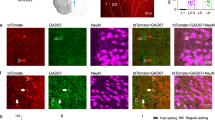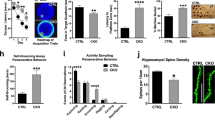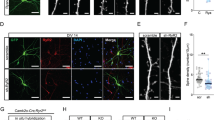Abstract
Dopamine D2 receptors (D2R) are G protein–coupled receptors that modulate synaptic transmission and are important for various brain functions, including learning and working memory. Abnormal D2R signaling has been implicated in psychiatric disorders such as schizophrenia. Here we report a new function of D2R in dendritic spine morphogenesis. Activation of D2R reduced spine number via GluN2B- and cAMP-dependent mechanisms in mice. Notably, this regulation occurred only during adolescence. During this period, D2R overactivation caused by mutations in the schizophrenia risk gene Dtnbp1 led to spine deficiency, dysconnectivity in the entorhinal-hippocampal circuit and impairment of spatial working memory. Notably, these defects could be ameliorated by D2R blockers administered during adolescence. Our findings suggest an age-dependent function of D2R in spine development, provide evidence that D2R dysfunction during adolescence impairs neuronal circuits and working memory, and indicate that adolescent interventions to prevent aberrant D2R activity protect against cognitive impairment.
This is a preview of subscription content, access via your institution
Access options
Subscribe to this journal
Receive 12 print issues and online access
$209.00 per year
only $17.42 per issue
Buy this article
- Purchase on Springer Link
- Instant access to full article PDF
Prices may be subject to local taxes which are calculated during checkout








Similar content being viewed by others
References
Howes, O.D. & Kapur, S. The dopamine hypothesis of schizophrenia: version III—the final common pathway. Schizophr. Bull. 35, 549–562 (2009).
Miyamoto, S., Duncan, G.E., Marx, C.E. & Lieberman, J.A. Treatments for schizophrenia: a critical review of pharmacology and mechanisms of action of antipsychotic drugs. Mol. Psychiatry 10, 79–104 (2005).
Iizuka, Y., Sei, Y., Weinberger, D.R. & Straub, R.E. Evidence that the BLOC–1 protein dysbindin modulates dopamine D2 receptor internalization and signaling but not D1 internalization. J. Neurosci. 27, 12390–12395 (2007).
Ji, Y. et al. Role of dysbindin in dopamine receptor trafficking and cortical GABA function. Proc. Natl. Acad. Sci. USA 106, 19593–19598 (2009).
Green, M.F. Stimulating the development of drug treatments to improve cognition in schizophrenia. Annu. Rev. Clin. Psychol. 3, 159–180 (2007).
Stephan, K.E., Baldeweg, T. & Friston, K.J. Synaptic plasticity and dysconnection in schizophrenia. Biol. Psychiatry 59, 929–939 (2006).
Garey, L.J. et al. Reduced dendritic spine density on cerebral cortical pyramidal neurons in schizophrenia. J. Neurol. Neurosurg. Psychiatry 65, 446–453 (1998).
Glantz, L.A. & Lewis, D.A. Decreased dendritic spine density on prefrontal cortical pyramidal neurons in schizophrenia. Arch. Gen. Psychiatry 57, 65–73 (2000).
Kolomeets, N.S., Orlovskaya, D.D., Rachmanova, V.I. & Uranova, N.A. Ultrastructural alterations in hippocampal mossy fiber synapses in schizophrenia: a postmortem morphometric study. Synapse 57, 47–55 (2005).
Kolluri, N., Sun, Z., Sampson, A.R. & Lewis, D.A. Lamina–specific reductions in dendritic spine density in the prefrontal cortex of subjects with schizophrenia. Am. J. Psychiatry 162, 1200–1202 (2005).
Li, Z. & Sheng, M. Some assembly required: the development of neuronal synapses. Nat. Rev. Mol. Cell Biol. 4, 833–841 (2003).
Brennand, K.J. et al. Modelling schizophrenia using human induced pluripotent stem cells. Nature 473, 221–225 (2011).
Bonci, A. & Hopf, F.W. The dopamine D2 receptor: new surprises from an old friend. Neuron 47, 335–338 (2005).
Beazely, M.A. et al. D2–class dopamine receptor inhibition of NMDA currents in prefrontal cortical neurons is platelet-derived growth factor receptor–dependent. J. Neurochem. 98, 1657–1663 (2006).
Kotecha, S.A. et al. A D2 class dopamine receptor transactivates a receptor tyrosine kinase to inhibit NMDA receptor transmission. Neuron 35, 1111–1122 (2002).
Liu, X.Y. et al. Modulation of D2R-NR2B interactions in response to cocaine. Neuron 52, 897–909 (2006).
Li, Y.C., Xi, D., Roman, J., Huang, Y.Q. & Gao, W.J. Activation of glycogen synthase kinase–3 beta is required for hyperdopamine and D2 receptor–mediated inhibition of synaptic NMDA receptor function in the rat prefrontal cortex. J. Neurosci. 29, 15551–15563 (2009).
Boyer, C., Schikorski, T. & Stevens, C.F. Comparison of hippocampal dendritic spines in culture and in brain. J. Neurosci. 18, 5294–5300 (1998).
Peters, A. & Kaiserman–Abramof, I.R. The small pyramidal neuron of the rat cerebral cortex. The perikaryon, dendrites and spines. Am. J. Anat. 127, 321–355 (1970).
Harris, K.M. Structure, development, and plasticity of dendritic spines. Curr. Opin. Neurobiol. 9, 343–348 (1999).
Nagai, T. et al. A variant of yellow fluorescent protein with fast and efficient maturation for cell-biological applications. Nat. Biotechnol. 20, 87–90 (2002).
Yuste, R. & Bonhoeffer, T. Genesis of dendritic spines: insights from ultrastructural and imaging studies. Nat. Rev. Neurosci. 5, 24–34 (2004).
Bourne, J.N. & Harris, K.M. Balancing structure and function at hippocampal dendritic spines. Annu. Rev. Neurosci. 31, 47–67 (2008).
Tseng, K.Y. & O'Donnell, P. Dopamine–glutamate interactions controlling prefrontal cortical pyramidal cell excitability involve multiple signaling mechanisms. J. Neurosci. 24, 5131–5139 (2004).
Traynelis, S.F. et al. Glutamate receptor ion channels: structure, regulation and function. Pharmacol. Rev. 62, 405–496 (2010).
Håkansson, K. et al. Regulation of phosphorylation of the GluR1 AMPA receptor by dopamine D2 receptors. J. Neurochem. 96, 482–488 (2006).
Chen, X.W. et al. DTNBP1, a schizophrenia susceptibility gene, affects kinetics of transmitter release. J. Cell Biol. 181, 791–801 (2008).
Arranz, M.J. & de Leon, J. Pharmacogenetics and pharmacogenomics of schizophrenia: a review of last decade of research. Mol. Psychiatry 12, 707–747 (2007).
Glazer, W.M. Does loxapine have “atypical” properties? Clinical evidence. J. Clin. Psychiatry 60 (suppl. 10), 42–46 (1999).
Giovanni, G.D., Matteo, V.D. & Esposito, E. Seritonin-Dopamine Interaction: Experimental Evidence and Therapeutic Relevance (Elsevier Science, 2008).
Meltzer, H.Y. & Massey, B.W. The role of serotonin receptors in the action of atypical antipsychotic drugs. Curr. Opin. Pharmacol. 11, 59–67 (2011).
Tau, G.Z. & Peterson, B.S. Normal development of brain circuits. Neuropsychopharmacology 35, 147–168 (2010).
Jaaro–Peled, H. et al. Neurodevelopmental mechanisms of schizophrenia: understanding disturbed postnatal brain maturation through neuregulin–1–ErbB4 and DISC1. Trends Neurosci. 32, 485–495 (2009).
Suh, J., Rivest, A.J., Nakashiba, T., Tominaga, T. & Tonegawa, S. Entorhinal cortex layer III input to the hippocampus is crucial for temporal association memory. Science 334, 1415–1420 (2011).
Andersen, P., Morris, R., Amaral, D., Bliss, T. & O'Keefe, J. The Hippocampus Book (Oxford University Press, 2007).
Schultz, H., Sommer, T. & Peters, J. Direct evidence for domain-sensitive functional subregions in human entorhinal cortex. J. Neurosci. 32, 4716–4723 (2012).
Hasselmo, M.E. & Stern, C.E. Mechanisms underlying working memory for novel information. Trends Cogn. Sci. 10, 487–493 (2006).
Cho, Y.H. & Jaffard, R. Spatial location learning in mice with ibotenate lesions of entorhinal cortex or subiculum. Neurobiol. Learn. Mem. 64, 285–290 (1995).
Papaleo, F. et al. Dysbindin-1 modulates prefrontal cortical activity and schizophrenia-like behaviors via dopamine/D2 pathways. Mol. Psychiatry 17, 85–98 (2012).
Talbot, K. The sandy (sdy) mouse: a dysbindin-1 mutant relevant to schizophrenia research. Prog. Brain Res. 179, 87–94 (2009).
Baik, J.H. et al. Parkinsonian-like locomotor impairment in mice lacking dopamine D2 receptors. Nature 377, 424–428 (1995).
Drago, J. et al. Altered striatal function in a mutant mouse lacking D1A dopamine receptors. Proc. Natl. Acad. Sci. USA 91, 12564–12568 (1994).
Wang, H.D., Stanwood, G.D., Grandy, D.K. & Deutch, A.Y. Dystrophic dendrites in prefrontal cortical pyramidal cells of dopamine D1 and D2, but not D4, receptor knockout mice. Brain Res. 1300, 58–64 (2009).
Xu, M. et al. Dopamine D1 receptor mutant mice are deficient in striatal expression of dynorphin and in dopamine-mediated behavioral responses. Cell 79, 729–742 (1994).
Ji, Y., Pang, P.T., Feng, L. & Lu, B. Cyclic AMP controls BDNF-induced TrkB phosphorylation and dendritic spine formation in mature hippocampal neurons. Nat. Neurosci. 8, 164–172 (2005).
Fox, J.G. et al. The Mouse in Biomedical Research (Academic Press, 2007).
Lewis, D.A. & Levitt, P. Schizophrenia as a disorder of neurodevelopment. Annu. Rev. Neurosci. 25, 409–432 (2002).
Tabuchi, K. et al. A neuroligin-3 mutation implicated in autism increases inhibitory synaptic transmission in mice. Science 318, 71–76 (2007).
Fiorentino, H. et al. GABA(B) receptor activation triggers BDNF release and promotes the maturation of GABAergic synapses. J. Neurosci. 29, 11650–11661 (2009).
Cai, Y.Q. et al. Central amygdala GluA1 facilitates associative learning of opioid reward. J. Neurosci. 33, 1577–1588 (2013).
Fukata, Y. et al. Local palmitoylation cycles define activity-regulated postsynaptic subdomains. J. Cell Biol. 202, 145–161 (2013).
Wilkie, M.P. et al. The relationship between NMDA receptor function and the high ammonia tolerance of anoxia-tolerant goldfish. J. Exp. Biol. 214, 4107–4120 (2011).
Li, Z. et al. Caspase-3 activation via mitochondria is required for long-term depression and AMPA receptor internalization. Cell 141, 859–871 (2010).
O'Brien, J.A. & Lummis, S.C. Diolistic labeling of neuronal cultures and intact tissue using a hand-held gene gun. Nat. Protoc. 1, 1517–1521 (2006).
Chan, L., Terashima, T., Urabe, H., Lin, F. & Kojima, H. Pathogenesis of diabetic neuropathy: bad to the bone. Ann. NY Acad. Sci. 1240, 70–76 (2011).
Jiao, S. & Li, Z. Nonapoptotic function of BAD and BAX in long-term depression of synaptic transmission. Neuron 70, 758–772 (2011).
Belforte, J.E. et al. Postnatal NMDA receptor ablation in corticolimbic interneurons confers schizophrenia-like phenotypes. Nat. Neurosci. 13, 76–83 (2010).
Acknowledgements
We thank H. Arnheiter (NINDS/NIH) for critical discussion of the manuscript and E.J. Sherman for editing the manuscript. This work was supported by the Intramural Research Program of the National Institute of Mental Health (ZIA MH002281 to Z.L.).
Author information
Authors and Affiliations
Contributions
J.-M.J. conducted the experiments and data analysis. J.Z. analyzed mEPSCs. D.L. contributed to the CTB experiment. Z.L. and J.-M.J. designed the experiments and wrote the manuscript. Z.H. generated the constructs and lentivirus expressing Drd1, Drd2 and the siRNAs against them.
Corresponding author
Ethics declarations
Competing interests
The authors declare no competing financial interests.
Integrated supplementary information
Supplementary Figure 1 The D2R and D1R siRNAs are efficient and specific.
Cultured hippocampal neurons were transfected with D2R siRNA constructs along with constructs expressing HA–tagged D2R, siRNA–resistant D2R (D2R–M), Beclin1 or ATG5, and stained with anti–HA antibody at 3 d after transfection in (a–d). Representative images of transfected neurons are shown in (a, c). Quantification of expressed proteins is shown in (b, d); n = 15 neurons for each condition. (e) Cultured cortical neurons (DIV5) were infected with lentivirus expressing D2R siRNA, and lysed at DIV12 for RT–PCR of D1R and D2R. (f) mEPSC amplitude recorded in hippocampal slices prepared from 4–week–old C57BL/6 mice injected with lentivirus expressing EGFP, D2R or D2R siRNA; n= the total number of recorded neurons from 5–8 slices of 3–5 mice for each condition. Scale bar, 20 μM. Mann Whitney test was used for statistical analysis. Data are presented as mean ± SEM.
Supplementary Figure 2 D1R does not regulate spine number.
(a, b) Cultured hippocampal neurons (DIV14) were transfected with the Venus construct along with either the empty vector or the D1R construct, and treated with vehicle or agonists and antagonists of D1R for 24 h. Representative images of transfected neurons (top) and dendrites at a higher magnification (bottom) are shown in (a). Quantification for (a) is shown in (b). (c) Quantification of total spine density in primary hippocampal neurons (DIV17) treated with vehicle, D2R agonist or D2R antagonist. The results were replicated by three independent experiments. Histograms show one of the three replicates (n = 15 neurons for each condition). Scale bar, 20 μM for images of neurons and 5 μM for images of dendrites. Mann Whitney test was used for statistical analysis. Data are presented as mean ± SEM.
Supplementary Figure 3 Quinpirole induced GluN2B endocytosis is required for the effects of quinpirole on spines.
Primary hippocampal neurons (a, b, f–k) and cortical neurons (d, e) were treated with vehicle or quinpirole at DIV17 for 24 hrs. (a) Representative images of neurons stained for bassoon, synaptophysin, GluA1 or GluA2. (b) Quantification for (a). (c) The input–output relationship of EPSCNMDA recorded in hippocampal slices prepared from C57BL/6 mice intraperitoneally injected with D2R agonists (0.5 mg/kg of quinpirole or 10 mg/kg of bromocriptine). Since EPSCNMDA was comparable in quinpirole and bromocriptine treated slices (data not shown), data from these slices were pooled. n = 10 cells from 10 slices of 3 animals for each condition in (c). (d) Representative cropped immunoblots for phosphorylated GluN2B (Ser1303) and GluA1 (Ser845); the full–length images of western blots are shown in Supplementary Figure 7c. (e) Quantification for (d); n = 3 independent experiments. (f) Representative images of neurons transfected with the GFP–GluN2A construct. (g) Quantification for (f). (h) Representative images of GFP–GluN2B transfected neurons treated with 1 μM quinpirole alone or along with inhibitors for GluN2B (3 μM of ifenprodil or 1 μM of Ro 25–6891) or dynamin (20 μM). (i) Quantification for (h). (j) Representative images of neurons transfected with the Venus construct and treated with inhibitors as indicated. (k) Quantification of spine density for (k). For all images, n = 15 neurons for each condition. Scale bar, 20 μM. Mann Whitney test was used for statistical analysis. Data are presented as mean ± SEM.
Supplementary Figure 4 The amplitude of mEPSCs in CA1 neurons of wild–type and sandy mice At 3 weeks of age, sandy mice and their wild–type littermates were injected with lentivirus expressing EGFP or Drd2 siRNA, then used for mEPSC analysis.
n = the total number of neurons recorded from 5–8 slices of 3–5 animals each condition. Mann Whitney test was used for statistical analysis. Data are presented as mean ± SEM.
Supplementary Figure 5 The effect of D2R on spines in adult mice and the developmental change in the expression of NMDAR subunits in the mouse hippocampus.
In (a, b), 8–week–old wild–type or sandy mice were injected with lentivirus expressing EGFP, Drd2 or Drd2 siRNA, and analyzed for spines at 1 week after injection. In (c, d), the hippocampus of mice at 2–12 weeks were dissected and lysed for immunoblotting. (a) Representative images of dendrites from transduced CA1 neurons. (b) Spine analysis for (a); n = 15 neurons from 3 slices of 3 animals for each condition. (c) Representative cropped immunoblots; The full–length blots are shown in Supplementary Figure 7d. (d) Quantification for (c); n = the number of mice for each time point. Scale bar, 5 μm. Mann Whitney test was used for statistical analysis. p–values in (d) were calculated by comparing each GluN subunit at various postnatal weeks vs. that at 6 weeks. Data are presented as mean ± SEM.
Supplementary Figure 6 Entorhinal–hippocampal connectivity is changed by treating adolescent sandy mice with eticlopride, but not by treating adult wild–type mice with quinpirole.
(a) Sandy mice were fed water supplemented with eticlopride (5 μg/ml) or intraperitoneally injected with eticlopride (0.5 mg/kg) from P21 to P35, then injected with Alexa–555–conjugated CTB at 8 weeks of age to label entorhinal neurons projecting to the CA1 area. (b) Wild–type mice were fed water supplemented with 2.5 μg/ml quinpirole from P56 to P63, then injected with 1 mg/ml of CTB at 12 weeks of age. n = the number of animals. Mann Whitney test was used for statistical analysis. Data are presented as mean ± SEM.
Supplementary Figure 7 Full–length images of immunoblots.
For immunoblotting, after transfer, we cut each PVDF membrane into two parts. The top portion of the membrane was used to detect AMPA or NMDA receptors, and the bottom part was used to probe for actin or tubulin. (a) Full–length images for the cropped representative immunoblots for total NMDA receptors in Figure 3i. (b) Full–length images for the cropped blots for surface NMDA receptors in Supplementary Figure 3i. (c) Full–length images for the cropped blots in Supplementary Figure 3d. (d) Full–length images for the cropped blots in Supplementary Figure 5c. The bottom portion of the PVDF membrane in (c) was probed with the anti–actin antibody first, then with the anti-tubulin antibody.
Supplementary information
Supplementary Text and Figures
Supplementary Figures 1–7, Supplementary Tables 1–2 (PDF 4828 kb)
Rights and permissions
About this article
Cite this article
Jia, JM., Zhao, J., Hu, Z. et al. Age-dependent regulation of synaptic connections by dopamine D2 receptors. Nat Neurosci 16, 1627–1636 (2013). https://doi.org/10.1038/nn.3542
Received:
Accepted:
Published:
Issue Date:
DOI: https://doi.org/10.1038/nn.3542
This article is cited by
-
Activation of the Hippocampal DRD2 Alleviates Neuroinflammation, Synaptic Plasticity Damage and Cognitive Impairment After Sleep Deprivation
Molecular Neurobiology (2023)
-
Dopamine receptor D2 regulates GLUA1-containing AMPA receptor trafficking and central sensitization through the PI3K signaling pathway in a male rat model of chronic migraine
The Journal of Headache and Pain (2022)
-
Aberrant maturation and connectivity of prefrontal cortex in schizophrenia—contribution of NMDA receptor development and hypofunction
Molecular Psychiatry (2022)
-
Extrastriatal dopamine D2/3 receptor binding, functional connectivity, and autism socio-communicational deficits: a PET and fMRI study
Molecular Psychiatry (2022)
-
Dopamine D2 receptor regulates cortical synaptic pruning in rodents
Nature Communications (2021)



